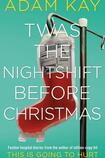
Between 2004 and 2010, when Adam Kay was working as a junior doctor – saving lives, delivering babies, clocking 97-hour weeks – he was also, unbeknownst to himself, writing a bestselling book. (I’m sure there are many among us who are waiting for the same to happen: a bestseller to emerge unbidden, like a tooth we’ve been grinding at in our sleep.) Still, This is Going to Hurt, made up of diary entries recorded during Kay’s non-existent spare time, was deserving of its accolades. Its merits are listed on the jacket of his newest release, Twas the Nightshift Before Christmas, a title equally deserving of high praise. “Hilarious”. “Hilarious”, “Hilarious”, “Hilarious”, “Hilarious” – we get 14 iterations of the word; two “Hilarious” columns. It’s all that needs to be said, apparently. Though, in truth, they might have put one outlier at the end: “Heartbreaking”.
In Doireann Garrihy’s The Laughs of Your Life podcast, she asks her guests to name a book that made them laugh out loud. I’m always waiting for someone to say This is Going to Hurt and a few episodes in, Deirdre O’Kane does the honours. She also says something that feels extremely relevant to Kay’s two books: “No audience is interested in the […]nice things that happen to you […]They want to know all the shit because we’re all in the shit – could you just turn it funny?” Adam Kay does just this: takes the shit and turns it funny.
There are seven Christmases in Twas the Nightshift Before Christmas, and Kay works all but one. He won’t mind because he is Jewish, people assume. “In fairness […]I was Jewish – and indeed still am,” he concedes, “but with the emphasis […]on the ‘ish’”. There’s an almost cringy humour here, which marks Kay’s style. Mixed in are lots of irreverent tales. There’s the man who arrives with “a ‘cock like a colander’” after getting acupuncture on his penis. Kay goes on to “insert an (advent) catheter”. Double cringe.
Alongside the humour, or perhaps inside it, we see failure. Failure of the body: a granny “outnumbered by E.coli bacteria” or an 82 year old with a strangulated hernia (causing “the kind of pain you’d expect if your intestines were in a vice”). We see the failure of the NHS, a toppling system that expects its employees to save lives during impossibly long shifts with no breaks. And there’s Kay’s failures: he climbs the ranks, compromising his own health and relationships to get there, and in the end never does – he resigns. This failure, in a way, is what gives the reader an in. Like doctors, it’s appropriate for us to take a look when the thing is broken.
We get the sense that Kay has become a bit bolder and more ready to address topics he might have been afraid of the first time around
Twas the Nightshift Before Christmas is a slim book. We get the sense that the material has been swept from the cutting room floor, not least because it ends with eight pages of “credits” which “really helps with the word count”, according to Kay. But it’s no worse because of this. If anything, we get the sense that Kay has become a bit bolder and more ready to address topics he might have been afraid of the first time around.
One scene in particular feels like the book’s raison d’être. I won’t spoil the effect by saying what it’s about, but Kay admits he didn’t include it in This is Going to Hurt because “I couldn’t face the thought of having to read it back again at various proofing stages”. It comes with a trigger warning and it’s harrowing. At no point do we feel like laughing. But at the end, the professor who had been teaching Kay reverts to an immediate state of jollity: “Right, we’re done ... who’s the next customer?... Are QPR playing today?” This is also what the book does; jumping to the next hilarious entry while we’re still wiping the tears away. And it’s what doctors are expected to do: bury the pain and move on. Keep working.
As an entity, though, this book does the opposite. It refuses to evade the truth. It exists in order to spread it.
In the last scene, Kay is at home with his family. It is Christmas. He has ceased his role as a doctor. In contrast to the other manic Christmases, this one feels quiet. It feels symbolic, like a heartbeat levelling out – like a thing dying. You wonder: is the whole system doing the same? Will anyone come to the rescue?









